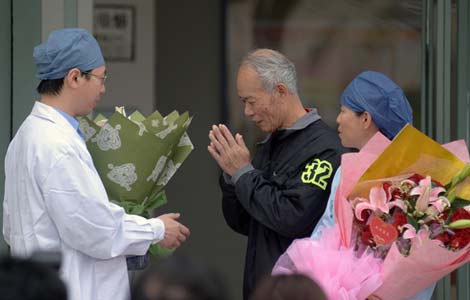Li Keqiang: a reform-minded premier
Updated: 2013-03-17 06:46
(Xinhua)
|
||||||||
Li insisted on cutting down the cabinet departments down to 25 to bring more efficiency. This round of cabinet restructuring is the seventh to take place in China since the country's reform and opening up in the late 1970s. Like any reform of its kind, this round represents a difficult challenge.
A commentary published in Nouvelles d'Europe, a Chinese language newspaper in Europe, said China's institutional restructuring will advance step by step, adding that it is high time for China's new leaders to translate their political courage and intellect into political decision-making.
In mapping out the plan, Li said administrative reform is not merely a reduction in the size of the cabinet, but a reform that prioritizes the transformation of functions. He called for decentralizing power over the market, society and local authorities by decreasing government intervention. Functional transformation is integrated with institutional restructuring in his proposal.
Led by Li, the drafting team carried out field research in multiple sectors, provinces and enterprises. Li presided over seminars to seek expert opinions that could aid in resolving difficult problems.
As vice premier, Li knew well how difficult coordination could become when multiple departments took charge of the same task. Food safety was supervised by a dozen of regulatory bodies, which often led to different regulators passing the buck in terms of doing their duty. Marine surveillance forces were spread among five departments, making them too divided to join hands.
Li has strongly advocated the change of age-old problems in the railway sector, which operated both as administrative agencies and enterprises. He also demanded the integration of departments in food safety and marine sectors with duplicate functions.
He has also pushed to reduce and decentralize government approvals for investment and businesses, as well as cut market access examinations and administrative charges. Since many entrepreneurs complain the business registry procedures are too complicated, Li helps change the system by granting licenses more freely. Entrepreneurs are now allowed to register their companies by agreeing upon registered capital, instead of actual contributions.
While reviewing a price reform plan for coal and electricity, Li approved of its market orientation but believed that it was too characteristic of a planned economy. "Given that all coal is sold at market price, why are there still restrictions on quantity and price? The contracts between enterprises brook no checks from the government. The contract law shall solely apply," he once said.
The plan had to be further revised for adoption. Now the revised version has been implemented, lending a strong push for the coal and electricity reform.
TRANSFORMATION
The 18th CPC National Congress urged the synchronized development of industrialization, IT application, urbanization and agricultural modernization. During his inspection of the State Grain Administration on January 15, Li summarized these "four modernizations," similar to the "four modernizations" of agriculture, industry, national defense and science and technology China put forward in the 1950s. New modes of modernization are expected to help China develop through transformation.
Li believes that the deep integration of industrialization and IT application is the orientation and impetus of industrial upgrades. He has noticed that the integration of IT and power-generating technology in developed countries can significantly boost the utilization of renewable energy generation by opening to small companies and families.
Since it is difficult to integrate wind and solar power into the grid, Li has called for studying energy development of foreign countries and opening the grid to small-scale distributed power generation by utilizing information technology. China's National Grid has since been connected to several small solar power generators operated by small companies and families.
- Brief introduction of Chinese vice-premiers, state councilors
- Premier Li nominates new State Council members
- Li Keqiang endorsed as premier
- Li Keqiang nominated as candidate for premier
- Legislature to appoint premier, senior military officials
- Premier Wen bids farewell, expresses gratitude
- Premier calls for hukou reform to be expedited
- Highlights: Premier Wen's government work report
- Premier spends New Year eve with disaster survivors
- Premier Wen listens to public on government work

 Li Na on Time cover, makes influential 100 list
Li Na on Time cover, makes influential 100 list
 FBI releases photos of 2 Boston bombings suspects
FBI releases photos of 2 Boston bombings suspects
 World's wackiest hairstyles
World's wackiest hairstyles
 Sandstorms strike Northwest China
Sandstorms strike Northwest China
 Never-seen photos of Madonna on display
Never-seen photos of Madonna on display
 H7N9 outbreak linked to waterfowl migration
H7N9 outbreak linked to waterfowl migration
 Dozens feared dead in Texas plant blast
Dozens feared dead in Texas plant blast
 Venezuelan court rules out manual votes counting
Venezuelan court rules out manual votes counting
Most Viewed
Editor's Picks

|

|

|

|

|

|
Today's Top News
Boston bombing suspect reported cornered on boat
7.0-magnitude quake hits Sichuan
Cross-talk artist helps to spread the word
'Green' awareness levels drop in Beijing
Palace Museum spruces up
First couple on Time's list of most influential
H7N9 flu transmission studied
Trading channels 'need to broaden'
US Weekly

|

|







